Watching hummingbirds flit from flower to flower in my garden is one of the simple joys in life, and I’m always trying to find ways to invite more of them into my yard.
Every year, I grow specific varieties of flowers just for hummingbirds (and choosing plants that bloom at different times ensures I get several different species of hummingbird visitors). While they prefer tubular-shaped blooms, they’re also attracted to some of the same flowers that bees, wasps, monarchs, and other pollinators love.
Read next: Plant these bee-friendly flowers in your garden
I also like to hang hummingbird feeders throughout the yard to encourage them to stick around, as well as offer a source of food in early spring or late fall (when most flowers are either not in bloom yet, or have faded for the season).
But instead of buying commercial hummingbird food, I make my own—and it couldn’t be easier. Homemade hummingbird food (hummingbird nectar) is inexpensive and so simple to make, and it’s infinitely better than store-bought hummingbird food that’s filled with artificial dyes and preservatives.
Want to know how to make your own and beautify your garden too? Keep reading!
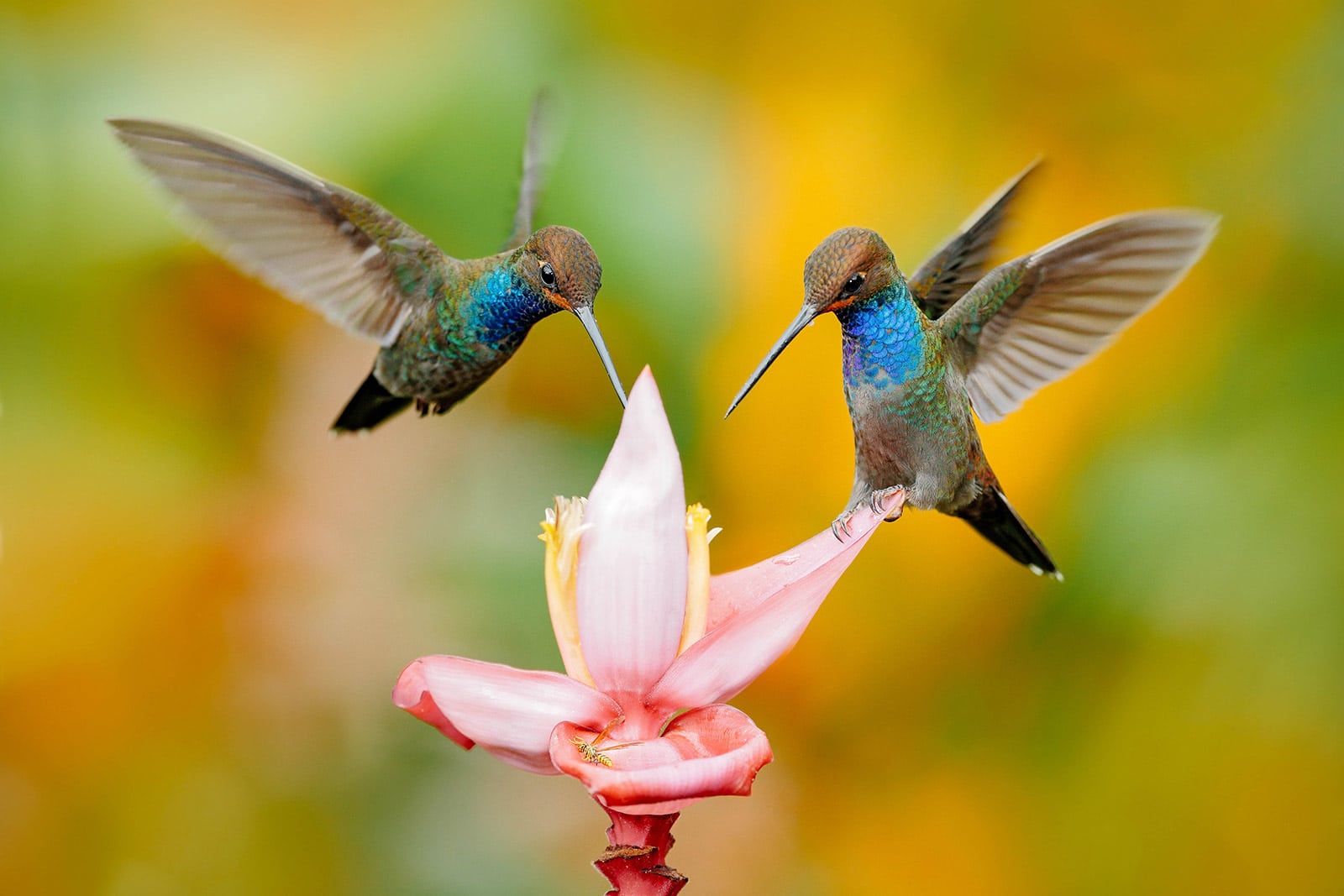
Homemade hummingbird food (nectar) recipe
My recipe for hummingbird food is super simple and closely mimics natural flower nectar. All that’s needed are two household ingredients and two pieces of equipment.
What you’ll need
- 1 cup plain white sugar
- 4 cups hot water
- Large spoon
- Mixing bowl (preferably with a pouring spout/lip)
- Funnel (optional)
- Hummingbird feeder
Method
- Stir the sugar and hot water in your mixing bowl until the sugar is dissolved. (What you end up with is a light simple syrup.)
- Let the syrup cool down to lukewarm or room temperature.
- As soon as the syrup has cooled, carefully pour it into your hummingbird feeder of choice (using a funnel if needed). Store any unused syrup in a lidded container in the fridge for up to two weeks.
You can make this recipe as often as needed. Just be sure to wash the feeder thoroughly before your next batch.
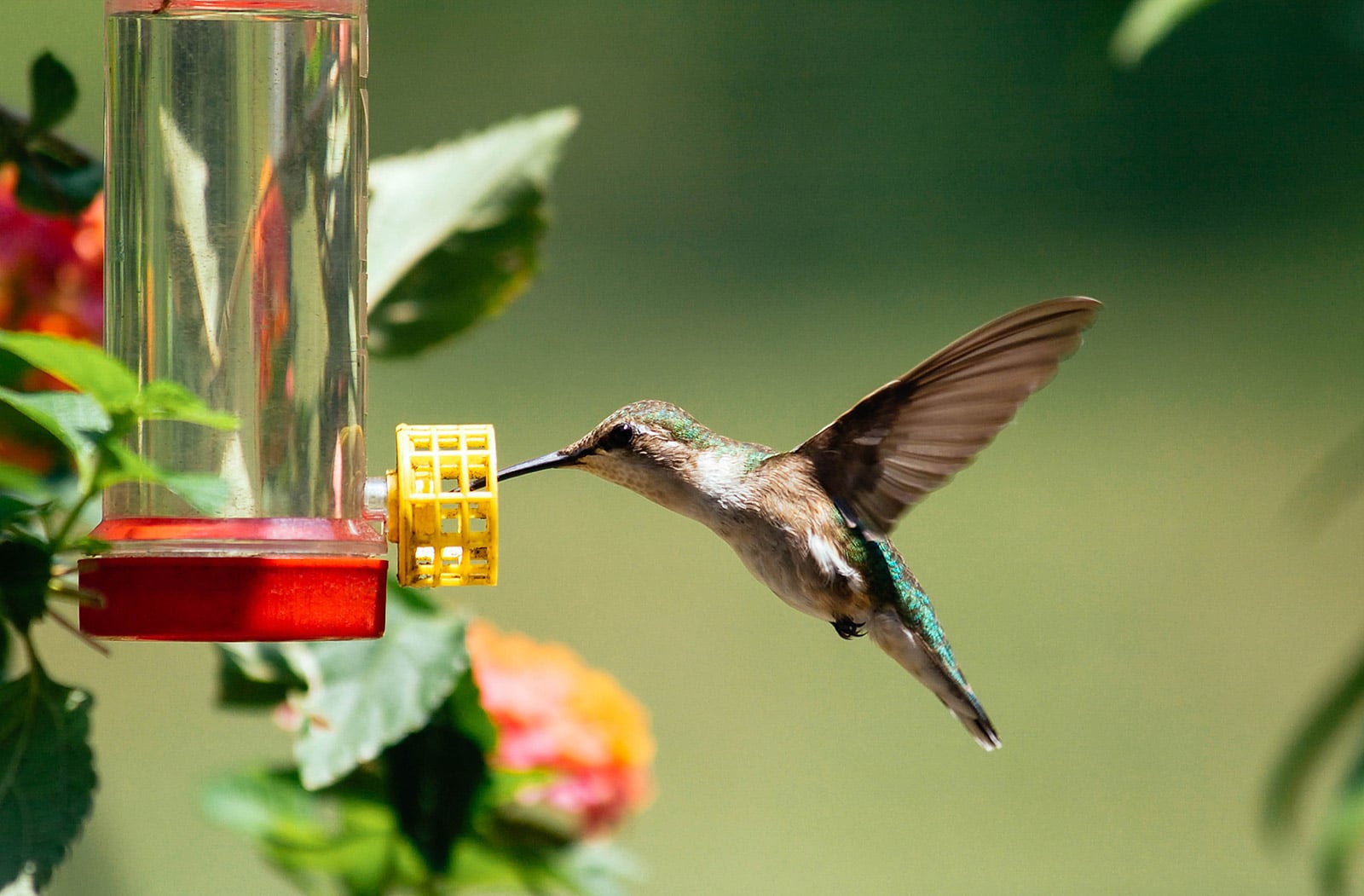
The ideal sugar-to-water ratio
When making your own hummingbird food at home, the ideal ratio of sugar to water is 1 part sugar to 4 parts water.
This formula can be scaled up or down accordingly, as long as the ratio remains the same. Too much or too little sugar can be harmful to hummingbirds, so avoid deviating from this recipe.
The one exception to this rule is during wintertime, when a ratio of 1 part sugar to 3 cups water gives hummingbirds a much-needed boost of energy and helps keep the syrup from freezing.
If you have a small feeder, you can make hummingbird food by combining just 1/4 cup plain white sugar and 1 cup hot water. This reduces waste since hummingbird food has to be changed out frequently, and large batches should be stored in the refrigerator for no more than two weeks.
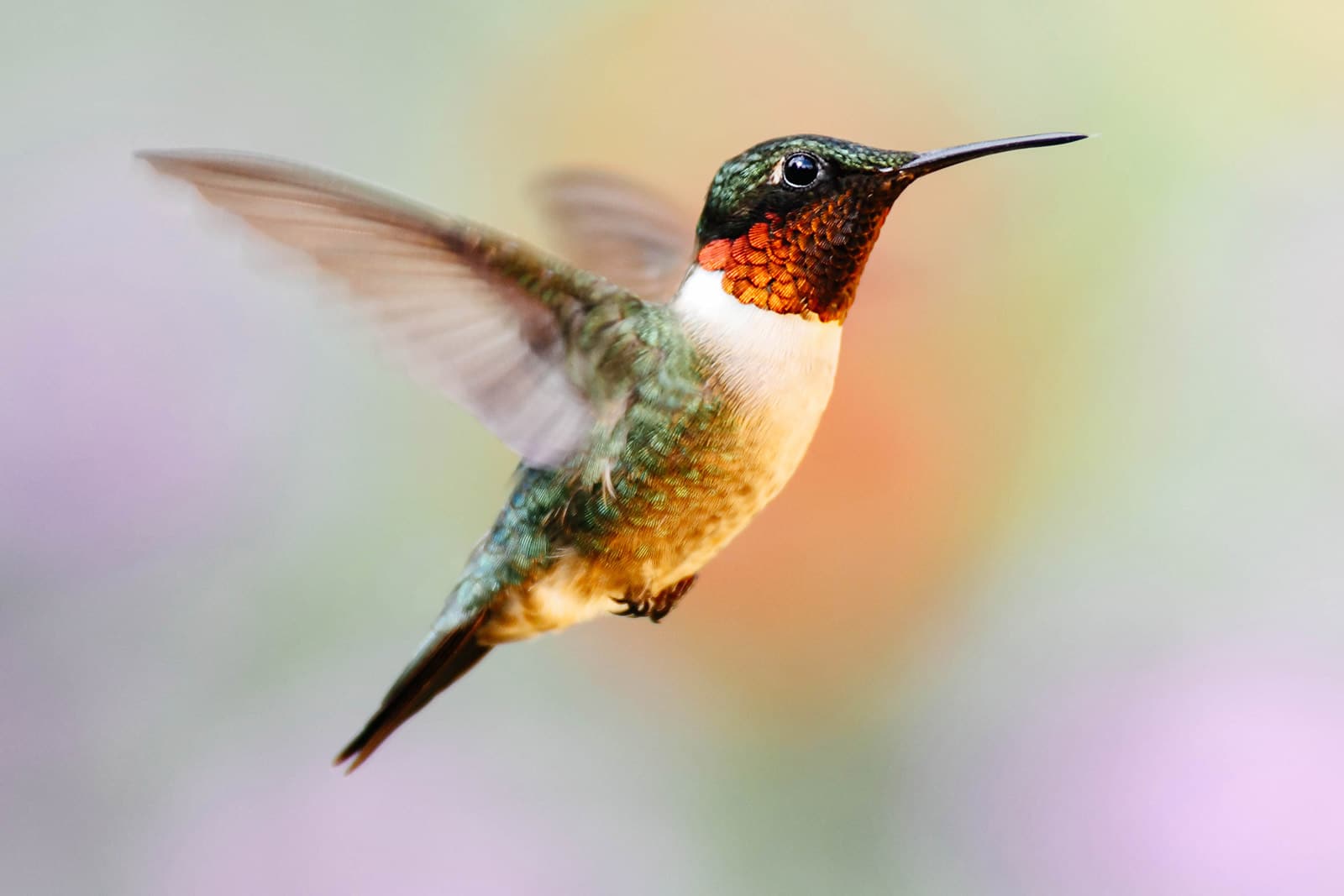
Can you use brown sugar for hummingbird food?
No! Please do not use brown sugar in place of plain white sugar for homemade hummingbird food. Brown sugar is not suitable for hummingbirds.
You should also avoid honey, agave nectar, demerara sugar, caster sugar, confectioners sugar, and “raw” cane sugar—anything that is not 100 percent white refined sugar.
I also advise against using organic sugar unless it’s pure white in color, since organic sugar may contain small amounts of molasses (giving it that familiar off-white to brownish tint). Molasses is rich in iron, and iron can be toxic to hummingbirds even in small doses.
This is one of the few times where using an otherwise good and healthy natural sweetener is not good or healthy at all (when it comes to hummingbirds, that is).
Do you need to add food coloring to hummingbird food?
No! You do not need to add food coloring to any homemade hummingbird food. Artificial dyes and colors can be harmful to hummingbirds since they cannot digest the chemicals in them.
Hummingbirds are attracted to color, but your hummingbird feeder should do a good job at attracting them with its bright colors and designs.
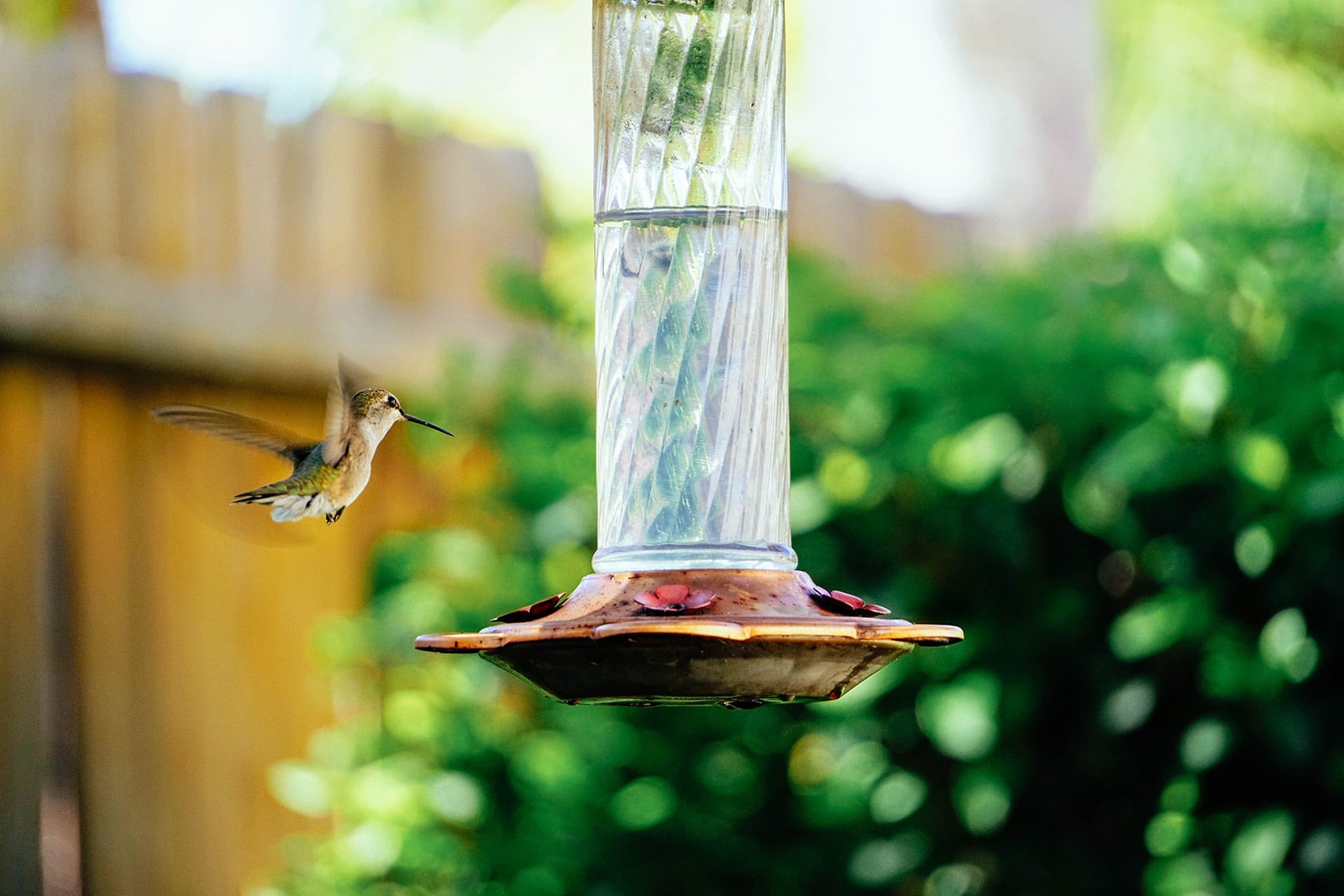
Disclosure: If you shop from my article or make a purchase through one of my links, I may receive commissions on some of the products I recommend.
What’s the best hummingbird feeder to use?
For the most part, all hummingbird feeders are created equal. The best feeder to use is the one that suits your personal style and space!
You can find beautiful hummingbird feeders made from handblown glass, feeders that look like mason jars or antique glass bottles, fun designs like cacti and textured balls, minimalist feeders that fit into any modern garden setting, compact feeders that suction to a window (if you don’t have a tree limb to hang one from), and even tiny feeders that you can wear as a ring! (Imagine a hummingbird landing on your hand to take a sip? It’s a hit with kids especially!)
Many hummingbird feeders have an 18- to 32-ounce capacity, but there are smaller feeders that hold just 4 ounces, 8 ounces, or 12 ounces of nectar (perfect if you have a small space or balcony garden).
You can find all my recommended hummingbird feeders in my Amazon store right here.
How often should you change a feeder?
To maintain freshness, change out the hummingbird food at least once a week, though best practice is to wash and refill the feeder every four to five days. In very hot weather, you may need to change out the hummingbird food even more frequently.
If the homemade hummingbird food in your feeder becomes goopy, cloudy, or moldy, take down the feeder, dump out the nectar, wash with hot water, and fill with fresh nectar.
Always empty, clean, and fill your hummingbird feeder with fresh homemade hummingbird food—don’t just top it off when it becomes low.
Dirty, contaminated food can be detrimental to hummingbirds.
How to clean your feeder
Between refills, wash your hummingbird feeder with hot water (and a mild detergent, if necessary) to remove any sticky residue. Be sure to thoroughly rinse the feeder so no soap remains inside.
A bottle brush is handy for more effective cleaning, and for any small, tight areas (like fake flowers), a toothbrush can be used to scrub them clean.
Some hummingbird feeders are even dishwasher safe, so be sure to check the instructions that came with the feeder.
At least once a season, or before I leave on a long trip, I disinfect my hummingbird feeders in a vinegar solution to help keep them clean.
Related: How to maintain a garden while you’re traveling
To do this, disassemble your feeder and soak all the parts in a bucket or sink filled with 1 part vinegar + 2 parts water for at least an hour. Swish the parts around to ensure every surface makes contact with the vinegar solution, then drain and either towel dry or air dry.
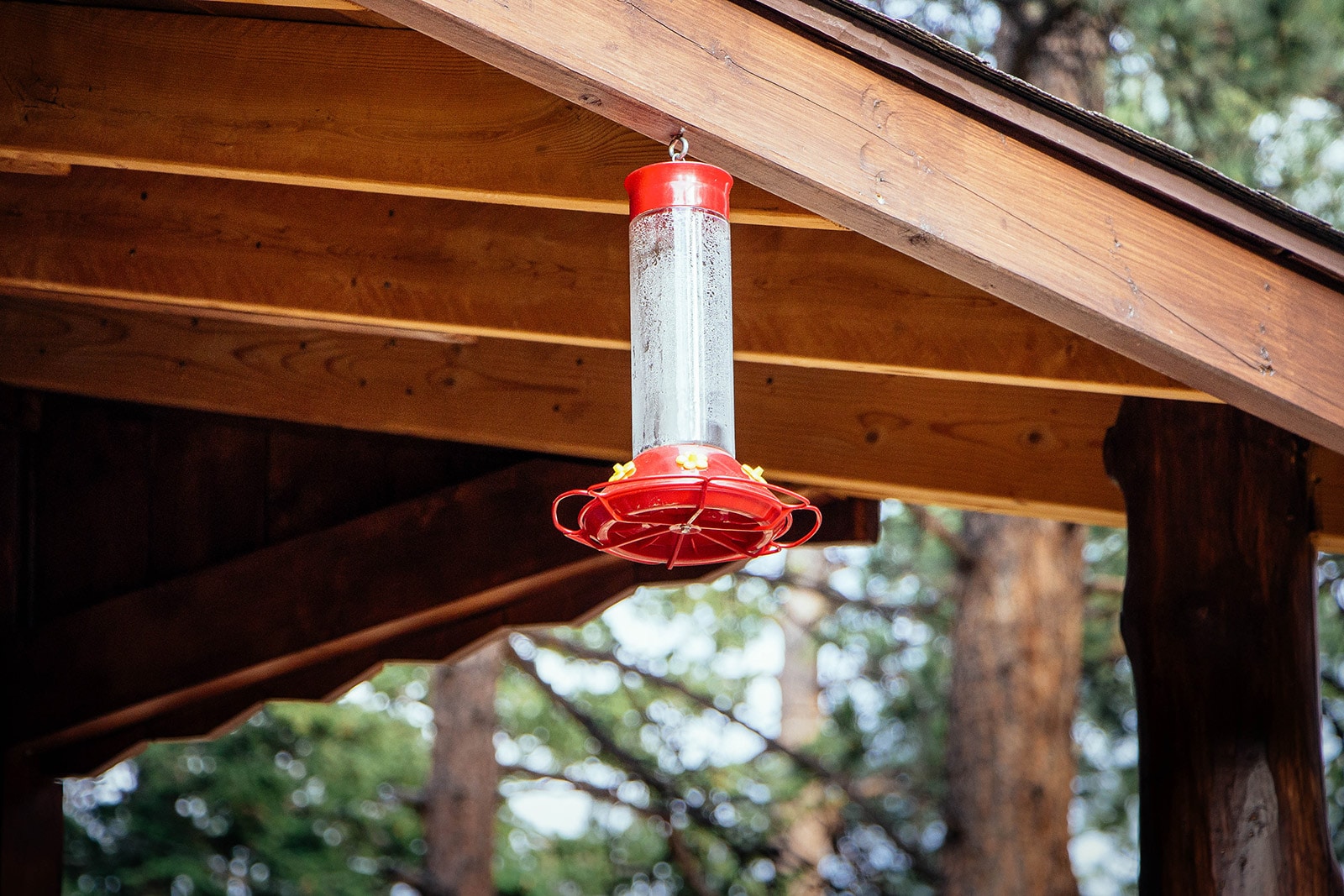
Where to hang your feeder
Personally, I like to hang my hummingbird feeders where I can see them—not only for the pleasure of seeing these playful birds dance in my garden all day, but also to remind me to fill and clean them each week.
After all, a neglected (or forgotten) feeder, hung in an out-of-the-way area of your yard, will do more harm than good.
When choosing an ideal spot to hang your feeder, keep these pointers in mind:
- Homemade hummingbird food spoils more quickly in the sun and heat, so try to avoid hanging your feeder where there’s direct sun all day.
- Hang the feeder in a shady or partially shady location that’s sheltered from wind and rain (on a tree with a large canopy, or under an eave or covered porch, for instance).
- Hang the feeder at least 4 to 5 feet above the ground to help keep it out of reach of pets, predators, and other garden critters. If you don’t have a high enough tree branch or structure, you can use a tall, sturdy shepherd hook like this one.
When to hang it up (and take it down)
Hummingbirds start arriving in the garden in spring as temperatures warm up. But exactly when you should hang your hummingbird feeder depends on where you live.
In the United States, people in the north can generally put out their feeders by late April. Southern states can aim for late February to early March. All other states fall somewhere in between.
It’s best to hang your feeder before you see any hummingbirds in your garden, since you want the food to be ready and available for those first early arrivals.
In winter, leave your hummingbird feeder up for at least three weeks after you see the last hummingbirds, since you never know when a hungry straggler may migrate through your yard. Here in Oregon where I live, we see Anna’s hummingbirds all winter so I try to keep a feeder up, even on the coldest days. (I’ll share how I keep my feeder from freezing in the next section below.)
If you live in a climate with year-round hummingbird populations (like California, Arizona, Texas, and Florida), then your feeder should stay up all year, except maybe in peak season when you have a wide variety of flowers in full bloom (which provides the hummingbirds with plenty of “wild” nectar to feed on).
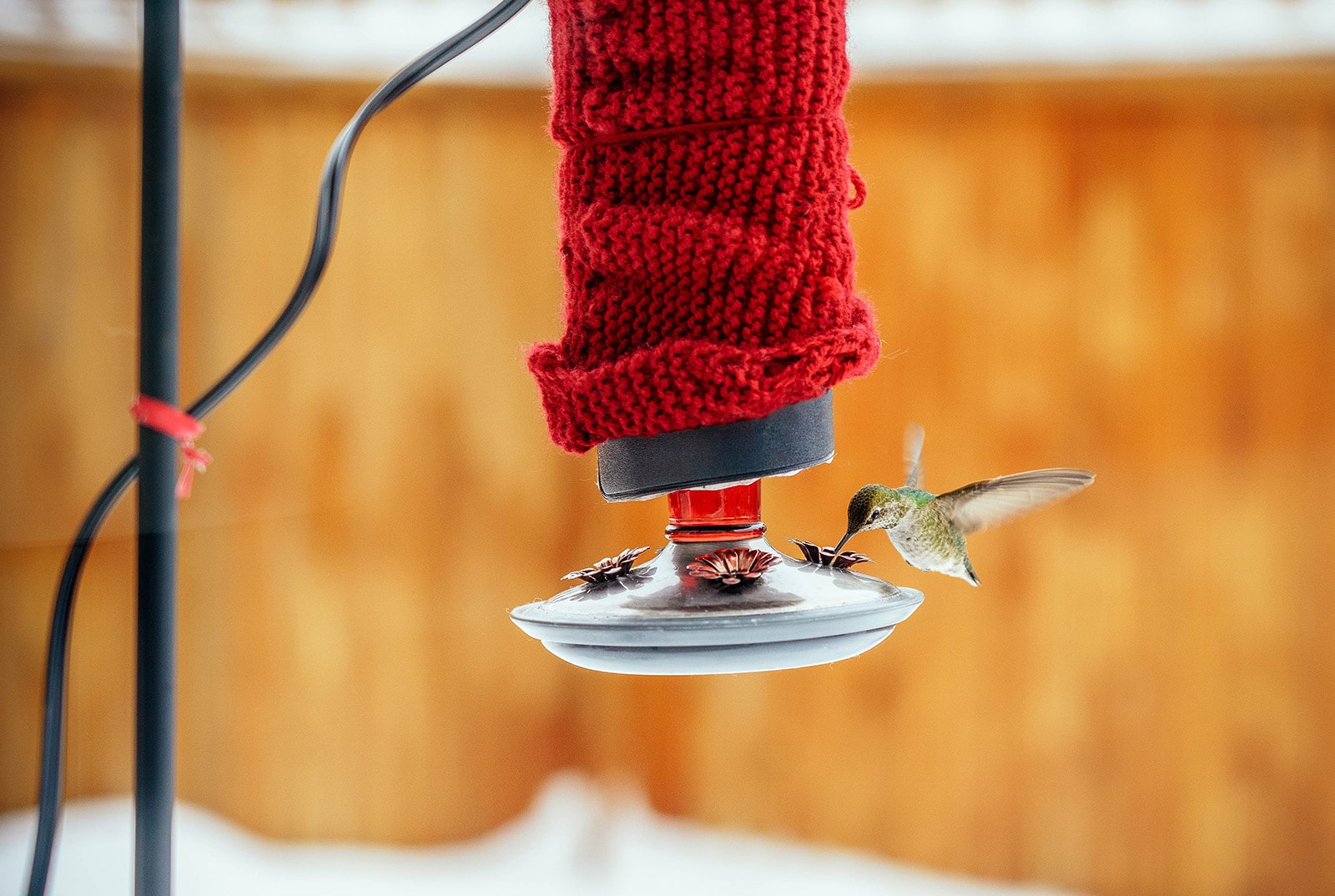
How to keep hummingbird nectar from freezing in winter
If cold weather has arrived in your garden but the hummingbirds have not quite left yet, you can keep your feeder going until the very last drop (and visitor).
The standard 1-to-4 sugar-to-water solution for hummingbird nectar freezes at 29°F, but starts to get slushy at around 27°F.
However, using a 1-to-3 ratio of sugar to water lowers the freezing point of the syrup, which helps delay (or prevent) your homemade hummingbird food from freezing.
If your area is prone to cold snaps overnight, bring the feeder in each evening to keep it from freezing. Just remember to hang the feeder again early in the morning, as hummingbirds often begin to feed before sunrise.
Location matters: a hummingbird feeder in a protected area, away from wind and close to the house, is less likely to freeze than a feeder that’s out in the open.
I personally like this hummingbird feeder heater, which keeps nectar thawed to 5°F to 15°F (depending on the bulb you use). It attaches easily and securely to most flat-bottom feeders (the most common style) and uses very little power.
You can also wrap your hummingbird feeder in incandescent holiday string lights (not LED lights) for a festive look that does double duty by keeping the feeder (and nectar) just warm enough in winter.
In a pinch, hand warmers will work. These are the single use, disposable hand warmers you find in sporting goods stores. Most require you to shake them up to activate the heating element. You can tape these hand warmers to your feeder and let the gentle heat warm your feeder overnight.
And finally, insulation is key when it comes to keeping hummingbird nectar from freezing. You can use many different household materials to wrap around your feeder, including items that might otherwise be recycled or discarded. Some simple ideas for insulation include:
- Bubble wrap
- Burlap
- Garden frost cloth (this is a good way to repurpose an old or damaged one from last season)
- Oven mitts
- An old sweater, cut and sewn to size (or you can knit a new one specially for your feeder)
- An old tube sock with the toe cut off, stretched to fit over a feeder
- Foam pipe insulation, cut to size and secured with rubberbands, tape, or zip ties
For more ideas, this page has lots of pictures sharing clever ways to keep hummingbird food from freezing in winter.
You might also find these posts helpful:
- How to Make Bug Food: An Easy Way to Attract Beneficial Insects to Your Garden
- How to Attract Ladybugs to Your Garden (and Actually Keep Them Around)
Homemade Hummingbird Food (Nectar)
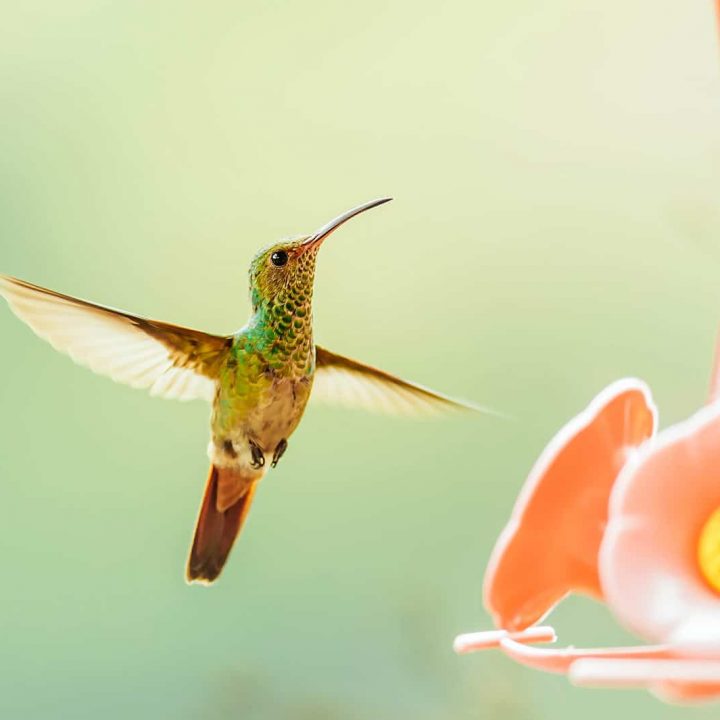
Homemade hummingbird food (hummingbird nectar) is inexpensive and so simple to make, and it's infinitely better than store-bought hummingbird food that's filled with artificial dyes and preservatives.
Materials
- 1 cup plain white sugar
- 4 cups hot water
Tools
- Large spoon
- Mixing bowl (preferably with a pouring spout/lip)
- Funnel (optional)
- Hummingbird feeder
Instructions
- Stir the sugar and hot water in your mixing bowl until the sugar is dissolved. (What you end up with is a light simple syrup.)
- Let the syrup cool down to lukewarm or room temperature.
- As soon as the syrup has cooled, carefully pour it into your hummingbird feeder of choice (using a funnel if needed). Store any unused syrup in a lidded container in the fridge for up to two weeks.
Notes
Avoid using honey, agave nectar, demerara sugar, caster sugar, confectioners sugar, and "raw" cane sugar—anything that is not 100 percent white refined sugar.
I also advise against using organic sugar unless it's pure white in color, since organic sugar may contain small amounts of molasses (giving it that familiar off-white to brownish tint). Molasses is rich in iron, and iron can be toxic to hummingbirds even in small doses.


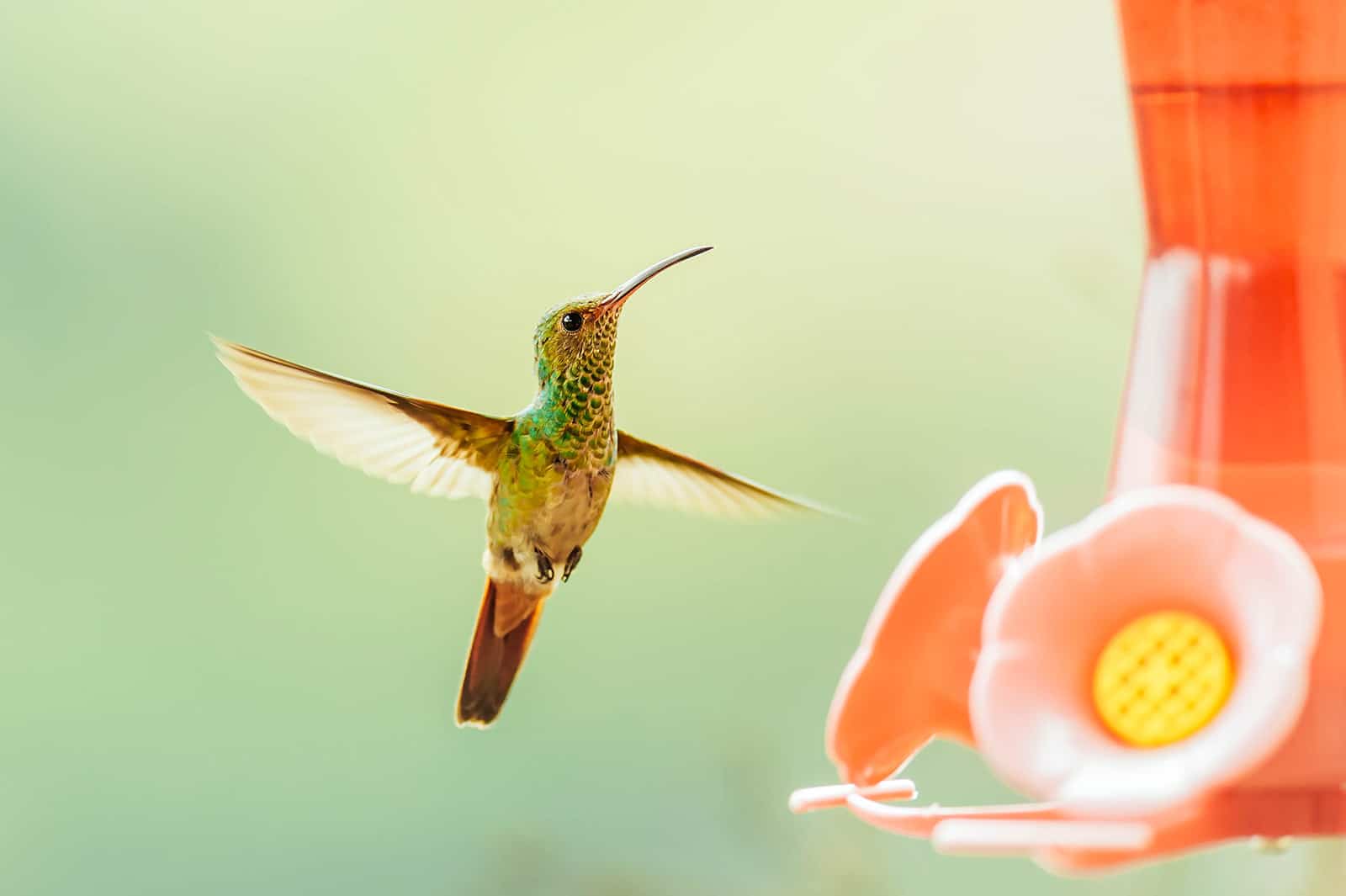













I’ve been using this recipe for several years with one difference. The recipe I got was the same amount but to combine them and bring to a boil for a minimum of two minutes–I use three minutes. Don’t know if it makes it any safer but doesn’t hurt.
I’ve been feeding hummers here in Montana for about 3 decades. I was given a great book on every aspect of hummingbirds. The book is: Hummingbird Book by Donald & Lillian Stokes; I recommend it. The recipe included in the book is 4:1 (4 parts water to 1 part sugar), which is pretty standard, I think. What’s different from your recipe is that it says to boil the solution for 1 to 2 minutes. This helps to “retard fermentation. Sugar-and-water solutions are subject to rapid spoiling, especially in hot weather. Do not leave sugar and water in a hummingbird feeder longer than 48 hours when the temperature is over 60 degrees.” I’ve always boiled my solution for 1 minute, and I have visitors coming back every year, so I guess they like it! Just an FYI: they can’t survive on sugar water alone; they also eat small insects and spiders as well as the tiny insects inside the flowers they visit. Get the book!
I followed the water sugar recipe for the hummingbird all I got was a dish full of ants
You need to put a ant moat above it they sell them on Amazon or you can make your own like I did with a coat hanger and cut a plastic bottle and half and glued it on the wire above it fill it with water now the ants can’t get to the feeder
Hi Linda, Thank you for you comprehensive post on making hummingbird nectar! We have been feeding “our” hummingbirds for years (using white cane sugar, no food coloring). We had leftover caster sugar from a recipe, and I searched the web on whether it can be used in hummingbird nectar instead of white cane sugar. I didn’t find much on the topic, but your article came up and warned against using caster sugar. I did additional research, and according to what I found, caster sugar is simply white sugar that is ground “superfine.” I don’t see why using it should be a problem (and it might even dissolve more rapidly in boiling water). What are your thoughts? Thanks again!
Great article, I leave in Las Vegas and have my usual suspects hang around all year now that the weather patterns have changed, they have built nests in a eucalyptus tree in my back yard and had the thriller or watching a mother and baby land in one of my feeders and saw mother teaching the baby how to suck on the nectar, what a treat that was, unfortunate they come and go, love those little Hummers.
I have several feeders but the problem I have is ants getting into the nectar. I have one feeder where the top of the feeder has a little saucer where you can put water so the ants can’t get in the feeder. But it evaporates so quickly.
Ant guards (traps) worked well for me (don’t need them currently). I used the one made by Wildlife Accessories and thought it was great. I looked online and saw it listed for basically $7.50…but shipping is so expensive-I’d check at a good bird store (Wild Birds Unlimited usually carries ant guards). I checked mine and it holds about 5 oz water full to the top and the current version is 1″ deeper (3″ versus my 2″) so that should be almost 8 oz water. Anyway, I hope it would work better than the saucer…
I have used petroleum jelly on the filament string that I use to hang my feeders and have eliminated the ant problem. Realize it’s not a one-and-done solution, you have to reapply the jelly on occasion. Good luck!
You can buy the ant moats on Amazon at Walmart or with temu just make sure when you hook the bird feeder on to the moat that you put water in the moat that detours the ants and they can’t get into the nectar…
Informative article, but do stress that beet SUGAR is also harmful to hummingbirds. And that the ONLY sugar safe to use is Pure Cane White sugar.
I beg to differ with not using raw organic sugar. I will not purchase refined white sugar for the word refined. It is man touched manufacturer sugar and my hummy will not touch it. I use my unrefined sugar organic not the raw stuff you find at restaurants in those tiny packages those do have molasses. This un refined cane sugar. The refined white sugar is peculiar these days it doesn’t de solve like the unrefined and like I said my hummy won’t touch it they like my unrefined. Also hummingbird feeder’s with those metal parts don’t buy them first of all metal isn’t good for hummy if you can even get them to eat out of one. And if they do some of the parts are very dangerous to their precious beaks . Also they will not eat out on the open range they prefer their feeders to be under cover. Never use detergent in your cleaning regimen they will not feed if detergent is used better to stay clear of detergent mine won’t go back to feeding if I use any kind of soap in my bottle even if I rinse really well. Use vinegar if needed or salt then rinse baking soda works really well rinse well though. I live in Washington I have them all year round. I have to bring my feeders in at night in cold weather. I also use filter water they do not like tap water and it has chemicals in it so I use filter water and they enjoy it better. I do have a bee problem when it comes to my feeders but haven’t found anything to keep them out of my mouths of feeders so any suggestions? Would be appreciated.. happy humming .
I recommend using a saucer-style hummingbird feeder like this one or a bee-proof design like this one that’s friendly to the long beaks of hummingbirds, but not to bees. You can also buy bee guards separately (like these ones) to add to your existing feeder. Make sure it doesn’t have a leak as well.
Thanks so much for the recipe. I just love watching the hummingbirds as they flit around our garden.